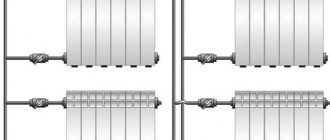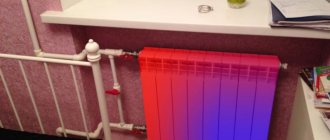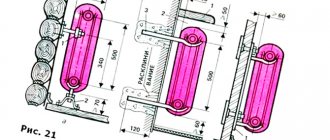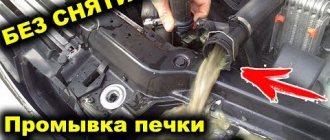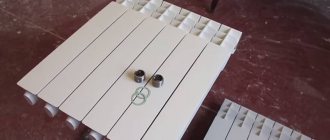There are frequent situations when the problem of a heating battery not heating arises. Sometimes you have to rack your brain in search of the reasons why the situation is happening and how to fix it. We have collected for you 7 possible reasons why radiators may not heat up and offer to study each in detail.
Important! This article is especially relevant when starting heating systems. Many, like you at the moment, may be experiencing difficulties with batteries. Your repost of our material may help someone quickly solve their problem. Don't forget to click on the social buttons. networks at the very bottom of the article!
Diameter matters
If a bypass is not provided when installing the heating system, and the battery is simply connected to an existing riser, there may be problems due to the diameter of the pipes.
When passing through the riser, the flow of water is divided. If a pipe with a smaller diameter than the riser is connected to the radiator, little coolant will get into it. It will cool down quickly and the battery will feel cold or barely warm to the touch.
There are two solutions:
- Replace the pipe from the riser to the battery with a similar one, but of a larger diameter;
- Install a bypass and close it enough to reach the desired temperature.
Basic information about the design of the heating system
The heating system comes in two types: one-pipe, the so-called Leningradka, and two-pipe. In apartment buildings, single-pipe is predominantly used. The vast majority of individual properties and recent new buildings use a two-pipe system.
In a single-pipe system, the coolant enters a single riser, from where it is distributed to the radiators. Supply is carried out from the first or last floor, which is not of fundamental importance. Bypasses are used to ensure uniform water supply to all batteries. Thanks to them, the required amount of water enters the radiator, the rest moves to the next sections. The disadvantage of a one-pipe system is that batteries that are located closer to the inlet or boiler warm up better. The furthest ones in the system may not warm up enough.
Two-pipe heating system
In a two-pipe system, each radiator is independently connected to two risers. Hot water is supplied from one, cooled water goes to the other. Ignorance of the features of heating systems of various types sometimes leads to dire consequences, especially when unskilled workers are involved in repairs.
Infrequently, but there are cases when old batteries in a single-pipe system are replaced with modern aluminum ones. The expected effect does not occur, because aluminum appliances are designed for a two-pipe system, the coolant current weakens. Moreover, due to poor water circulation, they become clogged. There is only one way out - to repair old batteries or install new ones suitable for a single-pipe system.
Air is the enemy
If the battery is hot at the bottom and cold at the top, airiness may be the cause. Especially with a bottom or saddle connection. If a coolant or low-quality water circulates through the heating system, it can react with metals and plastics.
This releases air, hydrogen or other gas. It accumulates at the top of the radiator. Air or other gas is blocking the flow of water or coolant. The heat output of the radiator decreases and it cools down quickly.
The solution to the problem is simple - you need to bleed the air from the heating battery. The Mayevsky crane is used for this purpose. It is located at the end of the upper part of the radiator instead of a plug. To remove gas:
- Place a small container (glass, cup) under the lower part of the Mayevsky tap;
- Start unscrewing the tap until you hear a characteristic hissing sound;
- First, air will come out of the hole, then its mixture with water;
- When clean water or coolant flows out of the hole, turn off the Mayevsky tap.
Bleeding air from the heating radiator through the Mayevsky tap.
Advice
If the radiator does not have a Mayevsky tap, install it. For this:
- Close the supply and return valves.
- Unscrew the top plug.
- Select a Mayevsky tap that is suitable in diameter and thread pitch.
- Install it in place of the plug and open the valves.
- Wait 3-5 minutes and release the remaining air.
Balancing valve
Privately owned houses have the greatest variety of heating systems. Cases of two or three branch structures are not uncommon. In this case, as in the above cases, the tendency of the liquid to take the shortest route naturally remains. The longest arm may have no circulation at all or very weakly expressed. The heat transfer of such a link will be the same - small, absent. The battery will not heat or heat poorly.
To eliminate the situation, it will be necessary to install a balancing valve in order to equalize the pressure of different branches and uniform heating.
Let's check the bypass
The principle of operation of the bypass system is simple. The more the valve is closed, the greater the amount of coolant passes through the heating device. Accordingly, its temperature and heat transfer are higher.
If the bypass valve is open, try turning it off halfway. The temperature of the radiator sections should rise. If this does not happen, close the valve almost completely . If after shutting off the bypass the radiator does not heat up, the valve has failed. The only solution is to replace it.
Important
Do not close the bypass completely! If water or coolant for some reason does not pass through the radiator, then you will shut down the entire system. The pressure will increase and there will be a high risk of a break.
Bypass valve location for radiator with side connection.
A drastic measure is replacing heating batteries
Unfortunately, old radiators that have been heating your home for decades can no longer be brought back to life by flushing. If, even after general internal cleaning, the batteries remain cold when the riser heats up, they will have to be mercilessly replaced with new ones. Radiators made of stainless steel or chrome-plated are ideal for the bathroom. When purchasing a painted radiator, you should take into account the quality of paint application - in conditions of high humidity it must be impeccable.
A new radiator will solve the problem of insufficient heating
Aluminum heat exchangers have low operating pressure, so they are not recommended for installation in apartments located above the 8th floor. In addition to this drawback, they have another significant drawback - the inner surface of these products is susceptible to corrosion, so you should not expect long years of service from them.
Radiators with towel hangers are produced especially for bathrooms. They not only perform their main function, but also allow you to neatly hang towels for quick drying. To decorate your bathroom, you can choose unusual radiators, which are now easy to find.
Replacing radiators is a complex and time-consuming process that is best left to professionals. Naturally, major repairs should be planned for the season when the heating in the house is turned off.
Silt at the bottom
The water in central heating systems is of poor quality. Sediment falls out of it, forming a layer of sludge at the bottom of the radiator. When using low-quality or incorrectly selected coolants, the same thing happens.
As sediment accumulates, the throughput of the lower collector decreases. Less coolant passes through the heating radiator, it cools down quickly. Heat transfer decreases.
The problem can only be solved by flushing the radiator. To do this you need:
- Shut off the supply and return;
- Unscrew the radiator from the incoming and outgoing pipes;
- Wash it with special means.
We described this in more detail in the articles How to flush a heating radiator and How to remove a heating radiator without consequences.
Other reasons
A common reason is a reduced coolant flow rate. This problem can occur in several cases:
- Narrowed pipe section.
- The coolant moves at low speed directly in the heating system.
Low coolant movement speed occurs when the pump power is insufficient to circulate the liquid within the system. Water cannot overcome the radiator with sufficient speed and go into the outlet. A similar problem often arises in gravity systems; they completely lack additional equipment.
The simplest gravitational scheme
Narrowing of pipes occurs in several cases:
- Incorrect soldering of polypropylene pipes.
- Problems arise when installing an adjustment valve with a narrowed cross-section.
- Presence of deposits in the pipe, reducing throughput.
Control valve
Another possible reason is a fairly low room temperature. The coolant in the radiator cools faster and delivers the maximum amount of energy. It is quite natural that the bottom of the battery can be much colder.
Important!
It is necessary to conduct a consistent check of the system, evaluate the condition of all elements and find the cause of the problem. In the future, it will be necessary to eliminate it to ensure complete water circulation in the radiator.
Wrong radiator?
Some radiators have plugs installed. They block one channel between sections, directing the flow of coolant or water in the desired direction. Such heating batteries must be installed according to the rules, in accordance with the type of connection.
For some connection types, a plug is required. With its help, you can evenly distribute water or coolant throughout the entire volume of the heating device. In others, its presence will only interfere - the riser pipes will be hot and the battery will be cold.
The plug may cause air locks in one or more sections. It can interfere with the removal of air through the Mayevsky tap if installed in the upper part of the heating radiator manifold.
You can determine whether there is a plug using the documentation for the heating device or by visual inspection. Let's look at the issue in more detail, with illustrations.
Top connection
With this type of connection, the radiator must have a plug between sections 1 and 2 in the upper part. If the top of the radiator is hot and the bottom is cold, it is missing. You need to install it.
Bottom connection
Such batteries should not have a plug. If one of the sections is much warmer than the others, then it is installed at the bottom of the hottest section. It is necessary to remove the radiator and remove the plug.
Side connection
If the first section of the radiator is hot, and the rest are cold or slightly warm, a plug is installed between sections 1 and 2. If all sections are hot, and the last one is cold, the hole between the last and penultimate sections is blocked. We need to remove it.
Important
With a lateral connection, the temperature of the radiator sections drops depending on the distance to the pipes. There is no way to avoid this. The temperature difference is noticeable with a large number of sections.
Diagonal connection with bottom feed
With this connection, there should be no plug in the heating radiator. If available, there are two options:
- If the first section is significantly hotter than the others, the plug is located at the bottom, between the 1st and 2nd;
- If the last section is warmer, it is at the top between the last and penultimate ones.
Diagonal connection with top feed
This type of connection can work with a plug if it is installed between sections 1 and 2. If it is at the bottom, between the last and penultimate ones, then all sections will be cold. Only the last one will remain hot.
Human factor
A person can also become the direct cause of a non-heating radiator. And usually they are as follows:
- A riser that they simply forgot to turn on because “it was late and the plumbers were tired.”
- Closed valve of the automatic air vent system.
- Incorrect connection during installation.
- Child-closed three-way valve.
They can be solved by calling the appropriate support service, correctly connecting the battery (or bypass, see below), and carefully checking the taps.
Blockage in the riser
Sediment forms on the inner walls of heating pipes. Gradually its thickness increases. If the diameter of the riser pipe is larger than that going to the radiator, then the batteries will be cold. A sediment of small thickness significantly reduces the cross-section and throughput.
You can only check pipes for blockages visually. To do this, you need to turn off the heating throughout the riser and drain the water in the basement. After this, remove the radiator along with the taps and inspect the inner surface of the pipes.
The best option is to clean the pipes running from the riser to the radiators. If they are long, this will be difficult to do. You will have to use special pipe cleaning products. Their effectiveness depends on the type of deposit.
If it is not possible to turn off the riser or clean it, you can cover the bypass. This way you will reduce the throughput of the riser; water or coolant under high pressure will flow into the heating device. But this is a temporary measure.
Important
When the bypass is closed, the pressure in the system will increase. The risk of leaks at the connections of valves, pipes and heating radiators will increase.
Sediment on the walls of the heating pipe.
Why is the bottom of the battery cold and the top hot?
Often on construction forums people complain about heating systems - the bottom of the radiator is cold and the top is hot. It is worth noting that any radiator on top is warmer than on the bottom, but if the gap between these temperatures is too large, then most likely there is something wrong with the system. Moreover, this means that the battery produces less thermal energy than it should. After all, everyone knows that the efficiency of heating devices directly depends on the uniform heating of their surfaces.
Today we will try to figure out why this phenomenon occurs and what needs to be done about it.
How to change the battery in an apartment
Previously, we talked about how to quickly and easily replace a heating battery in an apartment with your own hands, in addition to this article, we advise you to read this information
Are the valves working?
Typically, each radiator has two valves - on the supply and return. With their help, you can regulate the flow rate of water or coolant. If one or both valves fail, flow capacity may be reduced.
You can check the operation of the valves experimentally. Try covering or opening them. If after 5-15 minutes (depending on the type of battery) the temperature of the radiator surface changes, everything is in order. If not, there is a problem with one or two valves.
To determine the cause, you will have to shut off the riser and drain the water . After this, disconnect the heating radiator and inspect the valves. Check if they block the channel. If one or both fail, replacement is necessary.
Return is hot and supply is cold
Why is the return hot and the supply cold? This is a rare occurrence. It can be observed when the pump is installed in reverse and without a check valve. This is also possible due to the operation of the heated floor pump. When the floor is first started and heats the structure, it operates at full capacity and can, under certain circumstances, change the circulation in the radiator circuit. Once the floor warms up, it may go away on its own. If the pipes are hidden, then you need to check whether the pipes (supply and return) are mixed up. You can do it in different ways: with water or just blow.
How to solve a problem?
The most rational way is to call a plumber. And the following tips will help you draw up a plan for resuscitation of your cold batteries with a specialist:
1. To get rid of traffic jams, you need to install a Mayevsky tap on the battery.
2. Rinse the radiator (it is more rational to do this before the start of the heating season).
3. Replace the battery. This option should be used only in a situation where all “resuscitation measures” have already been used. You should only buy a radiator from a reliable company.

